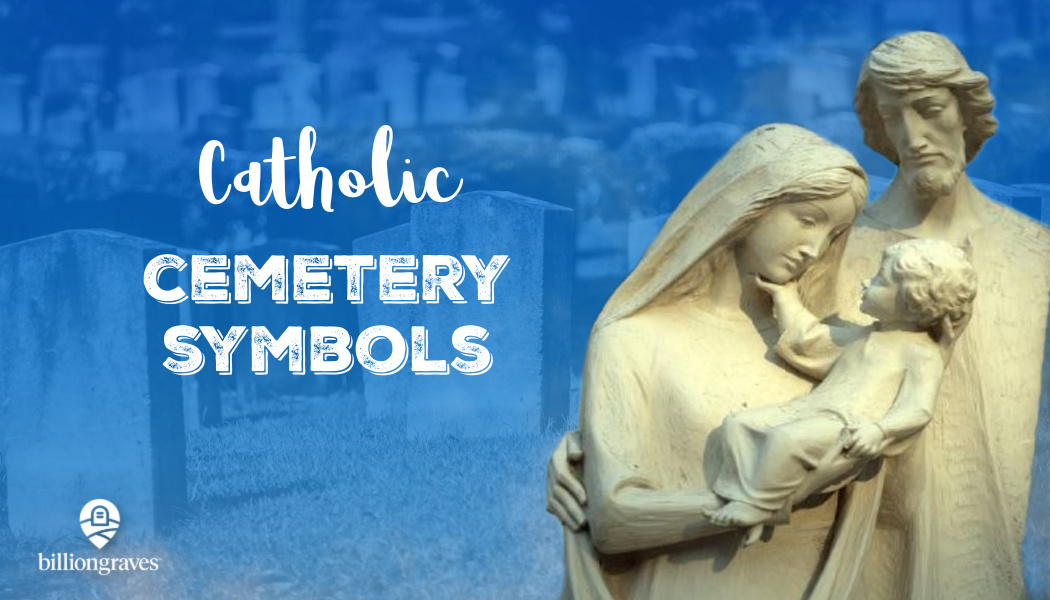Is your halo slipping or shining? Do you know why the rosary was invented? What does a sideways horizontal cross mean?
This blog post will help you understand Catholic cemetery symbols. And after that, your trips to the cemetery will never be the same!
My Grandmother said . . .
When I was a girl, one of my grandmothers often said that we were an ecumenical family. (To save you from looking it up . . . the word ecumenical means “the coming together of many religions in unity.”)
Some of our family members are Presbyterian, some Catholic, some Methodist, some Jewish, some are members of The Church of Jesus Christ of Latter-day Saints, and some are simply drifters.
I learned something important from each group. Here are some of the things that I learned from my Catholic grandmother:
- Life is better when God is at the center.
- God doesn’t care as much about what you wear as what is in your heart.
- Pray. Pray. And pray some more. I often “caught” her kneeling on the hard wooden floor by her bed, so I knew she prayed for me by name every day, even though I was one of many grandchildren.
I also learned about Catholic symbols from her. I’ll share some with you.
Catholic Cemetery Symbol: Halo

Have you ever tried painting or drawing a visible depiction of light? It’s hard, right? Try carving it in stone. Yeah. Then you can begin to see why light or glory began to be represented by a circle – it’s much easier to paint, draw, or sculpt.
A halo is symbolic of glory or the shining light that surrounds God and holy beings.
In the Old Testament is it recorded that when Moses entered into the presence of God he took on God’s glory or “shine” in his countenance.
Exodus 34: 29-30 says, ” . . . when Moses came down from Mount Sinai with the two tables of testimony in Moses’ hand, when he came down from the mount, that Moses wist not that the skin of his face shone while he talked with him. And when Aaron and all the children of Israel saw Moses, behold, the skin of his face shone, and they were afraid to come nigh him.”
So, we may understand that a halo or “shine” on a person shows their nearness to God or their resemblance to divinity. (We should all be working on our shine!)
Catholic Cemetery Symbol: Holy Family
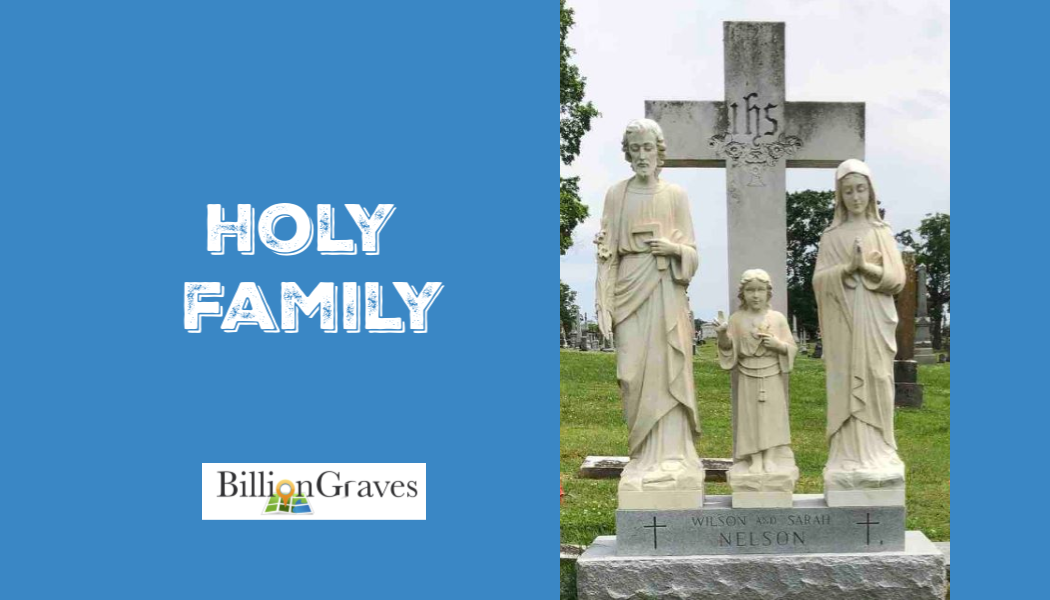
The Holy Family is made up of the Child Jesus, the Virgin Mary, and Saint Joseph. In the 17th century, Saint François de Laval (1623-1708) formally introduced the veneration of the Holy Family. Laval was the first Roman Catholic Bishop of what was then called New France and is now known as Canada.
The Feast of the Holy Family was instituted by Pope Leo XIII in 1893. It is a celebration held on the Sunday between Christmas and New Year’s Day in honor of Jesus, his mother Mary, and his earthly father Saint Joseph, as a family. The main purpose of this feast is to hold up the Holy Family as an ideal model for Christian families.
In the gravestone above Joseph holds lilies in one hand, a symbol of peace. In his other hand, he holds a square, signifying his life’s work as a carpenter used to provide for his family.
Jesus holds up one hand in a gesture of offering a blessing and with his other hand points to his own heart. Both are symbolic of love. Mary holds her hands in an attitude of prayer.
Purity, work, love, and prayer – sounds like a good recipe for an ideal family, doesn’t it?
Catholic Cemetery Symbols: IHS and Rosary

IHS stands for the first three letters (iota-eta-sigma) of the name Jesus in Greek: ΙΗΣΟΥΣ. On this gravestone, the name of Jesus is at the heart of the intersection of the cross, meaning he is at the center of the atonement and forgiveness.
The string of beads on this cross is a Holy Rosary, used in the Catholic Church to count the number of times rote prayers are repeated. The most common prayers recited while fingering a rosary are the Lord’s Prayer and the Hail Mary.
The beads are arranged in sets of ten for Hail Mary prayers, called decades, followed by one bead for the Lord’s Prayer. In addition, a Glory Be prayer is said while fingering the rope in between the sets of beads. Five decades are recited per rosary.
If all of this is sounding a bit complicated, you can see why rosary beads were introduced to keep track of the proper sequence and number of prayers.
Click HERE to see another IHS gravestone in an Australian cemetery on the BillionGraves website.
Our Father Prayer
Our Father, who art in heaven, hallowed be Thy name; Thy kingdom come; Thy will be done on earth as it is in heaven. Give us this day our daily bread; and forgive us our trespasses as we forgive those who trespass against us; and lead us not into temptation, but deliver us from evil, Amen.
Hail Mary Prayer
Hail Mary, full of grace. The Lord is with thee. Blessed art thou among women, and blessed is the fruit of thy womb, Jesus. Holy Mary, Mother of God, pray for us sinners, now and at the hour of our death. Amen.
Glory Be Prayer
Glory be to the Father, to the Son, and to the Holy Spirit, as it was, is now, and ever shall be, world without end. Amen.
Catholic Cemetery Symbol: Joseph the Worker
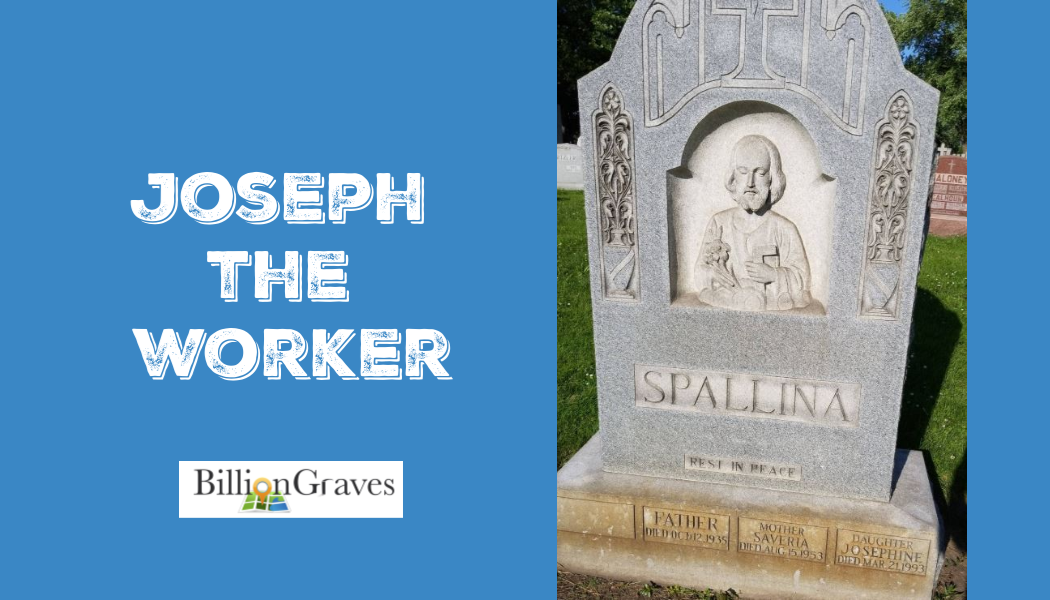
In 1955, Pope Pius XII was concerned about the May Day celebrations being sponsored by socialist, communist and anarchist groups around the world. They were marked by strikes and killings as the common workers struggled to establish the standard for an 8-hour workday.
So, in response to May Day, Pope Pius XII established the Feast of Saint Joseph the Worker, also to be held on May 1st. The Pope encouraged Catholics to pray to Saint Joseph about their working conditions and to honor Joseph as the earthly father of Jesus.

Little is known about Joseph. Since he does not appear in the Biblical writings about Jesus’ public life, death, or resurrection, many historians have assumed he died before Jesus started his ministry.
What is known about Joseph is that he was a carpenter, a common worker.
Pius XII emphasized this when he said, “The spirit flows to you and to all men from the heart of the God-man, Savior of the world, but certainly, no worker was ever more completely and profoundly penetrated by it than the foster father of Jesus, who lived with Him in closest intimacy and community of family life and work.”
Catholic Cemetery Symbol: Joseph with Lilies

Joseph is often depicted on Catholic gravestones holding lilies, as above, a symbol of his own purity and virtue. Joseph is considered to the protector of the Catholic Church, just as he was a protector of Mary and the young Jesus.
Catholics also consider Joseph the patron of a happy death, since it is standard Catholic belief that Joseph died a happy death himself in the presence of both Mary and Jesus.
Catholic Cemetery Symbol: Interlocked Rings
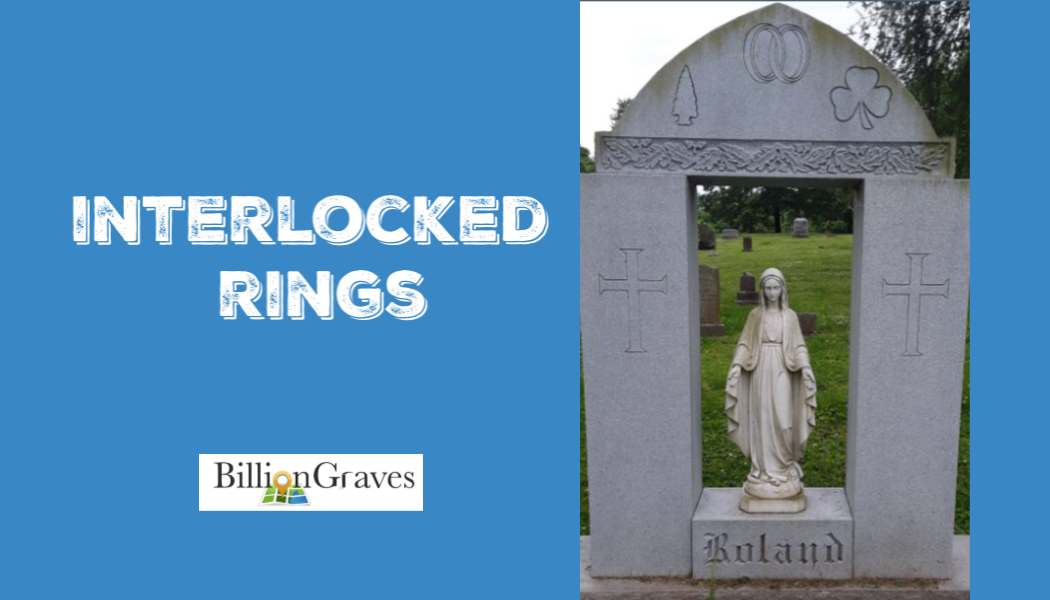
On this gravestone, the arrowhead and shamrock on either side of the interlocked rings indicate that a native American woman married an Irish man. (Roland is an Irish surname.)

Wedding rings symbolize eternity since they are round and have no beginning or end. Interlocked wedding rings symbolize unity and eternal love.
Catholic Cemetery Symbol: Sacred Heart

In 1956 Pope Pius XII taught, “Jesus has loved us all with a human heart. For this reason, the Sacred Heart of Jesus, pierced by our sins and for our salvation, ‘is quite rightly considered the chief sign and symbol of that… love with which the divine Redeemer continually loves the eternal Father and all human beings’ without exception.”
Throughout the New Testament Jesus’ love was poured out from His heart through miracles, the forgiveness of sinners, and compassion for the grief-stricken. Even while hanging on the cross, He showed love for those who were crucifying Him by saying, “Father, forgive them for they know not what they do” (Luke 23:34).
While many Christian religions recognize this great love that Jesus had for others, but it is uniquely Catholic to pray to the physical heart of Jesus. Catholics are also encouraged to strive to make their own hearts as loving as the Sacred Heart of Christ.
In a cemetery, if you see a statue of Christ, Mary, or saints – with the heart on the outside of the body, over the clothes, you can be sure that the deceased was Catholic. The heart will often have a crown on top of it (symbolizing victory), thorns around it (symbolizing sacrifice), and rays of light emanating from it (symbolizing love).
Catholic Cemetery Symbol: Sideways Cross

A sideways cross indicates that the crucifixion is over. Jesus Christ has already laid down his life, been removed from the cross, and risen from the dead. Hence, this symbol of Christ’s finished work shows faith that the departed soul will be resurrected.
Catholic Gravestone Symbols: Sun, Moon, Stars, and Prayer Rope
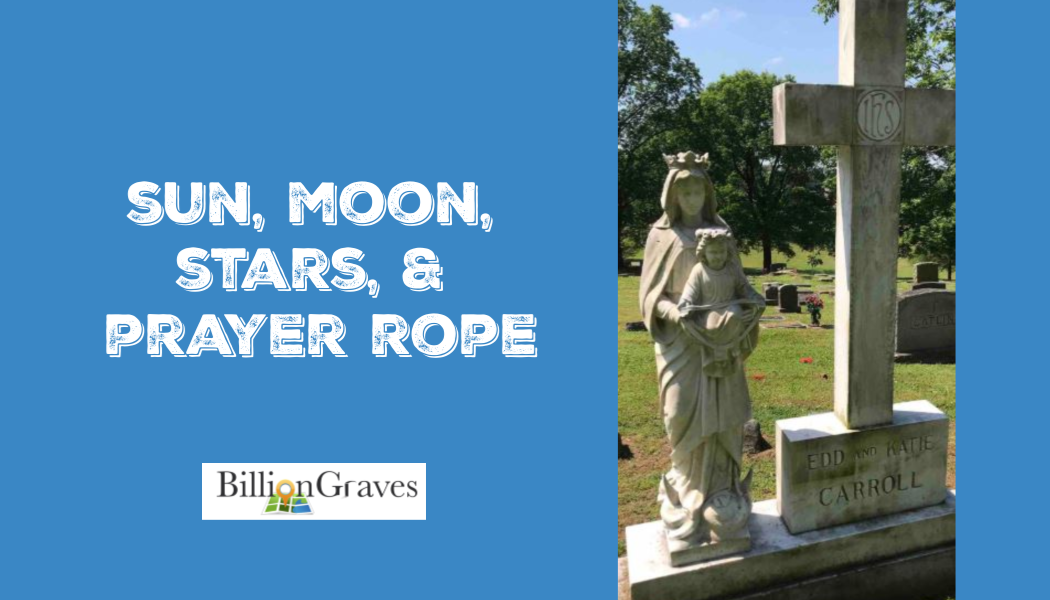
Why are there horns under Mary’s feet?
Many Catholic gravestones have statues of Mary with what appear to be horns beneath her feet. You may wonder what that is all about since she is venerated as the holy and pure virgin mother of Jesus Christ and horns are a symbol of the devil.
Well, they aren’t really horns at all. Look closer. It is a crescent moon, with the hem of her robe covering the center of the moon. This is in reference to Revelations 12:1 which reads, “And there appeared a great wonder in heaven: a woman clothed with the sun, having the moon under her feet, and on her head a crown of twelve stars.”
This statue of Mary also features a crown with twelve stars upon her head. And if the stone was in color it would likely show her robe shining white like the sun.
What is a prayer rope?
The Christ-child on this gravestone is holding a prayer rope, a device used to keep track of the number of prayers said. It is similar to a rosary, but much longer. It is often worn at the waist, whereas rosaries are worn around the neck.
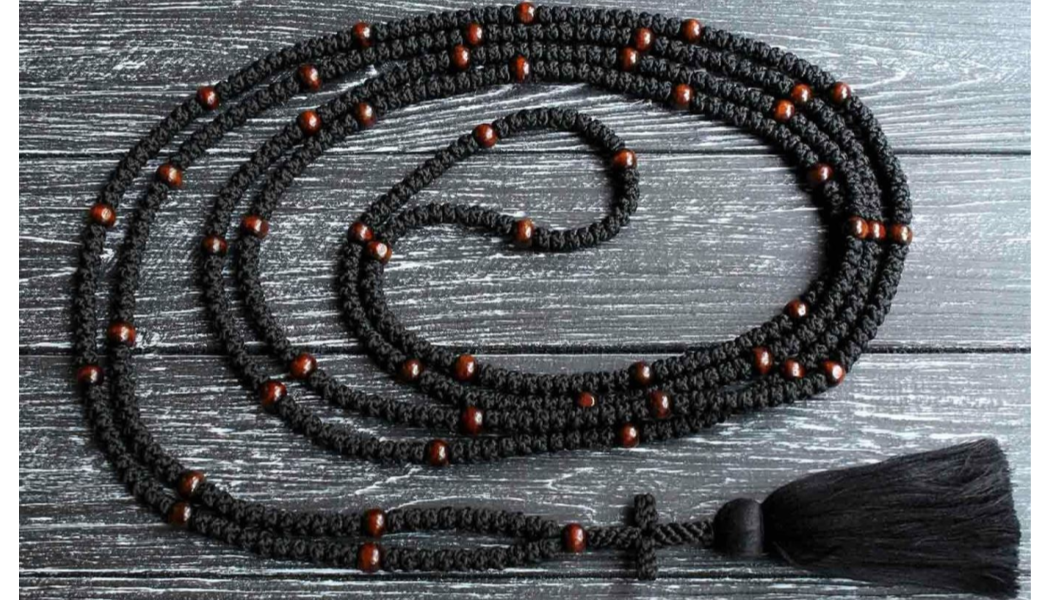
The invention of the prayer rope is attributed to the Catholic Saint Pachomius the Great (c. 292–348).
When Pachomius was a youth, a Roman army swept through his village in Thebes (Luxor, Egypt) on a recruitment drive and he was forced to become a Roman soldier. Although Pachomius never ended up in battle, he forever remembered the Christians who came daily to the army camps to bring food and comfort to the conscripted soldiers.
The kindness of these Christians impressed Pachomius so much that when he was able to leave the army he converted and was baptized. He soon began preaching to the shepherds in the fields. In so doing, he met monks who lived in nearby caves in the mountainsides.
Pachomius invited these monks to unite with him in forming a monastery where they would share all things in common. Before long, more than 100 monks had joined him.
One of the rituals at the monastery was to say a particular number of prayers each day. However, most of the monks were illiterate and could not count. So to solve this problem, those who could count put pebbles in a pile and each time a monk prayed, they tossed a pebble into a wooden bowl.
But it was cumbersome to carry the bowls around, so Pachmius devised prayer ropes with knots at particular intervals to keep track of prayers. The ropes could be looped onto the monk’s belted robes, making them easy to transport.
The most common number of knots in the ropes was 33, in remembrance of the number of years of Jesus Christ’s life. Each time a monk said a prayer they moved their fingers to the next knot. The ropes were fashioned in an unending loop. Thus, prayer ropes fulfilled the Apostle Paul’s injunction to “pray without ceasing” (1 Thessalonians 5:17).
Click HERE to see a gravestone sculpture of a woman in prayer from a cemetery in Hungary on the BillionGraves website.
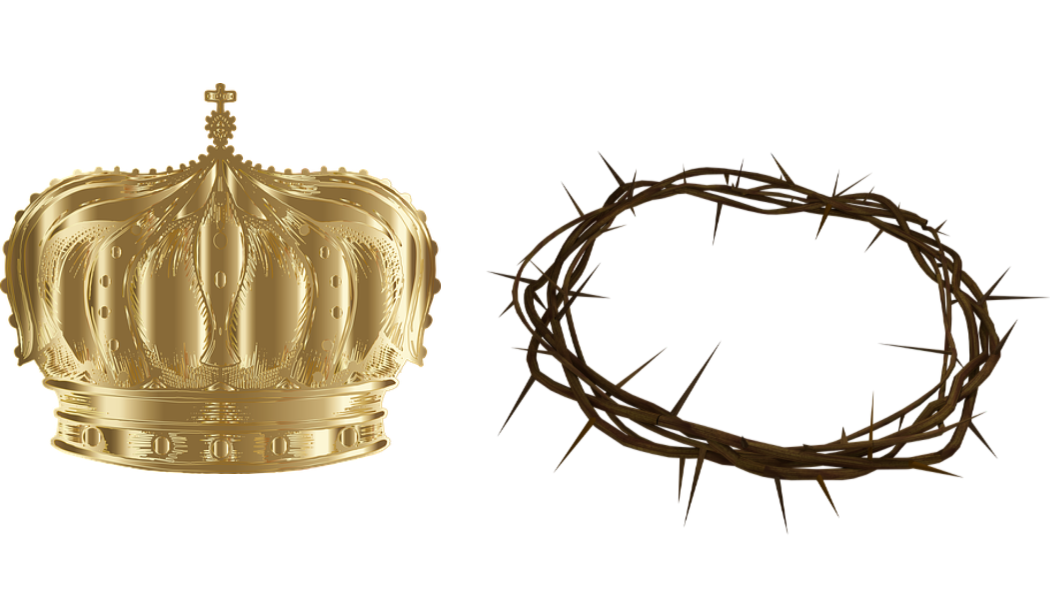
Why is Jesus wearing a crown?
Put simply, kings wear crowns. It is a symbol of royalty and power. The Bible refers to Jesus Christ as the “King of kings and Lord of lords” (Rev. 17:14).
The Roman soldiers who taunted Christ before the crucifixion wove a crown of thorns to mock his claim to authority. “And when they had plaited a crown of thorns, they put it upon his head, and a reed in his right hand: and they bowed the knee and mocked him, saying Hail, King of the Jews!” (Matthew 27:29).
Christ answered his accusers by saying, “My kingdom is not of this world” (John 18:36). A gravestone with a figure of Jesus wearing a crown shows that the family of the departed one believes that Christ will set up a kingdom beyond this life, for this life is not the end.
Catholic Cemetery Symbols: Chi Rho, Fleur de Lis, Dove, Sacred Heart, and A.M.D.G.

This Irish cross gravestone has a symbol at the center and one on each arm.
Cross Center: Chi Rho
The center of this cross has two letters intertwined. They are the first two letters of Jesus Christ’s name using the Greek alphabet: Chi (X) and Rho (p). This symbol was first used by Emperor Constantine.
It is said that the night before Constantine was sending his soldiers out to battle he prayed. Then he had a dream in which he saw the symbols of Chi-Rho, Christ’s name, in a sunset. He then put the symbol of the Christian god on his flags and on his soldier’s shields.
Standards and flags were very important to ancient armies as they went to war. First, the troops followed the flag as they marched into battle.
Now picture yourself as a soldier suddenly engaged in hand-to-hand combat. After a great struggle for your life, you looked about and realized that you were no longer with your battalion. They had moved on, leaving you behind. In order to return to safety, you need to find them as quickly as possible. So your eyes scan the horizon for your army’s flag on top of a tall labarum. Spying it across a field, you run to rejoin your comrades and fight by their side.
With the symbol of Christ’s name on Constantine’s flags, it was as if the soldiers were fleeing to Him for safety and fighting with Him by their side.
If you see the Chi Rho symbol in the cemetery, the deceased was most likely Catholic or Episcopalian.
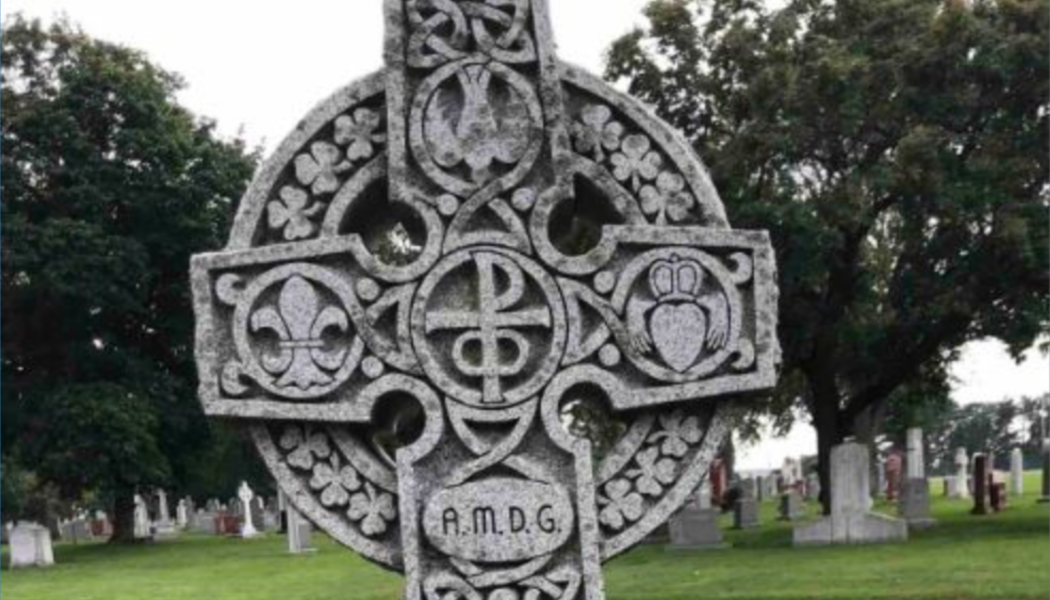
Cross Left-arm: Fleur-de-Lis
There are two interpretations of the fleur-de-lis symbol, seen on the left arm of this cross. The first is that it is a stylized white lily, an emblem of the Virgin Mary’s purity. The second interpretation is that the petals represent the Father, Son, and Holy Spirit with the band holding them together representing Mary.
Cross Top-arm: Dove
At the top of this cross is a dove descending from heaven. As noted in Catholic Gravestone Symbols, Part I, the dove is a symbol of forgiveness and peace.
Cross Right-arm: County Claddagh
On the right arm of this Irish cross is classic Claddagh symbol of the crown, heart, and hands. It is said that the crown is a symbol for loyalty, the heart for love, and the hands for friendship. The Claddagh symbol is often seen on jewelry, especially rings.
Legends say that the Claddagh symbol originated with a Galway fisherman, Richard Joyce. In the late 17th century, Joyce was captured by pirates and sold into slavery. While in servitude, he created a ring of gold with the three symbols of crown, heart, and hands for his true love back in Galway.

After his release from bondage, Joyce returned to his village of Claddagh in Galway where he married the woman who had waited years for his return.
Cross Bottom-arm: A.M.D.G.
The founder of the Catholic Jesuits coined the phrase “For the greater glory of God” or, in Latin, Ad majórem Dei glóriam (A.M.D.G.). The Jesuits were a Catholic order of missionaries founded in 1541. “For the greater glory of God” expresses the idea that temporal work may be considered holy if it is performed in order to give glory to God.

Catholic gravestone symbols bring hope to the family of the departed and express the faith of those who have gone before. May you have hope and faith in your life too!
To learn more about cemetery symbols check out these BillionGraves blog posts:
- Catholic Gravestone Symbols
- Understanding Cemetery Symbols Part I
- Understanding Cemetery Symbols Part II
- Understanding Cemetery Crosses
- Irish Gravestone Symbols
- Egyptian Gravestone Symbols
- Fraternity Gravestone Symbols
Volunteer
If you know of a church youth group or service organization that would be interested in taking photos of gravestones at their local cemetery, please send an email to Volunteer@BillionGraves.com and we will be happy to help you plan an event!
Happy Cemetery Hopping!
Cathy Wallace

